Protect Your DNS Privacy on Ubuntu 20.04/18.04 (DNS over TLS)
This tutorial will be showing you how to protect your DNS privacy on Ubuntu 20.04/18.04 desktop with DNS over TLS. We will use a tool called stubby to achieve that. But first, let me tell you why DNS is not secure.
DNS Vulnerability
DNS is insecure because by default DNS queries are not encrypted, which can be exploited by middle entities. DNS cache poison is one of the DNS abuses that is widely used by the Great Firewall of China (GFW) to censor Chinese Internet. GFW checks every DNS query that is sent to a DNS server outside of China. Since plain text DNS protocol is based on UDP, which is a connection-less protocol, GFW can spoof both the client IP and server IP. When GFW finds a domain name on its block list, it changes the DNS response. For example, if a Chinese Internet user wants to visit google.com, the Great firewall of China returns to the DNS resolver an IP address located in China instead of Google’s real IP address. Then the DNS resolver returns the fake IP address to the user’s computer.
What is DNS over TLS? How It Protects Your Privacy?
DNS over TLS means that DNS queries are sent over a secure connection encrypted with TLS, the same technology that encrypts HTTP traffic, so no third parties can see your DNS queries. Together with HTTPS and encrypted SNI (Server Name Indication), your browsing history is fully protected from ISP spying.
Stubby is an open-source DNS stub resolver developed by the getdns team. It uses the getdns library. A stub resolver is a small DNS client on the end-user’s computer that receives DNS requests from applications such as Firefox and forward requests to a recursive resolver like 1.1.1.1 or 8.8.8.8. Stubby is special in that it supports DNS over TLS. By default, it will only send DNS requests encrypted. There is another open-source stub resolver called cloudflared that supports DNS over HTTPS but stubby is already in Ubuntu 20.04/18.04 repository and is very easy to use.
How to Install and Use Stubby on Ubuntu 20.04/18.04 Desktop
Stubby is in Ubuntu 20.04/18.04 repository. Open up a terminal window and run the following command to install it.
sudo apt install stubby
This will install stubby and the getdns library. Once installed, stubby runs in the background. You you check its status with:
systemctl status stubby

Stubby listens on TCP and UDP port 53 of localhost (127.0.0.1), as can be seen by running this command:
sudo netstat -lnptu | grep stubby

The default stub resolver provided by systemd-resolved listens on TCP and UDP port 53 of 127.0.0.53.
sudo netstat -lnptu | grep systemd-resolv

The main configuration file is /etc/stubby/stubby.yml. Normally there’s no need to make changes to it unless you want to use another or your own recursive resolver. Let me explain some default configurations. You can open the file with:
sudo nano /etc/stubby/stubby.yml
The following line makes stubby run as a stub resolver instead of a full recursive resolver, which is why it’s named stubby.
resolution_type: GETDNS_RESOLUTION_STUB
The following configuration make stubby send DNS queries encrypted with TLS. It will not send quries in plain text.
dns_transport_list: - GETDNS_TRANSPORT_TLS
This following line requires a valid TLS certificate on the remote recursive resolver.
tls_authentication: GETDNS_AUTHENTICATION_REQUIRED
The following lines set the listen addresses for the stubby daemon. By default, IPv4 and IPv6 are both enabled.
listen_addresses: - 127.0.0.1 - 0::1
The following line make stubby query recursive resolvers in a round-robin fashion. If set to 0, Stubby will use each upstream server sequentially until it becomes unavailable and then move on to use the next.
round_robin_upstreams: 1
By default there are 3 recursive resolvers enabled in stubby configuration file. They are run by stubby developers and support DNS over TLS. You can see the full list of recommended servers on DNS Privacy website.
dnsovertls.sinodun.com 145.100.185.15 dnsovertls1.sinodun.com 145.100.185.16 getdnsapi.net 185.49.141.37
There are other DNS servers in the Additional Servers section that are disabled by default.
dns.quad9.net unicast.censurfridns.dk dnsovertls3.sinodun.com (supporting TLS1.2 and TLS 1.3) dnsovertls2.sinodun.com dns.cmrg.net dns.larsdebruin.net ......
There are also DNS servers listening on port 443. If port 853 is blocked in your network, you can uncomment them to use these servers.
dnsovertls.sinodun.com dnsovertls1.sinodun.com dns.cmrg.net dns.neutopia.org
Now you can exit nano text editor by pressing Ctrl+X.
Switching to Stubby
Editing the /etc/resolve.conf file to change name server is not recommended any more. Follow the instructions below to make systemd-resolved send DNS queries to stubby.
GNOME Desktop
Click the Network Manager icon on the upper-right corner of your desktop. Then select wired settings. (If you are using Wi-fi, select Wi-fi settings.)
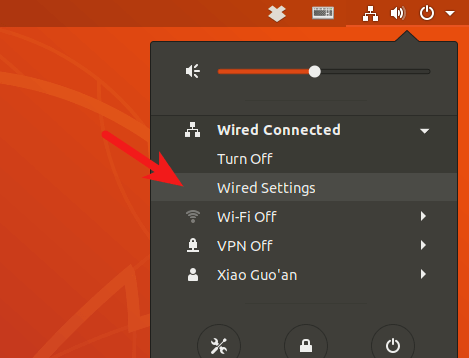
Click the gear button.
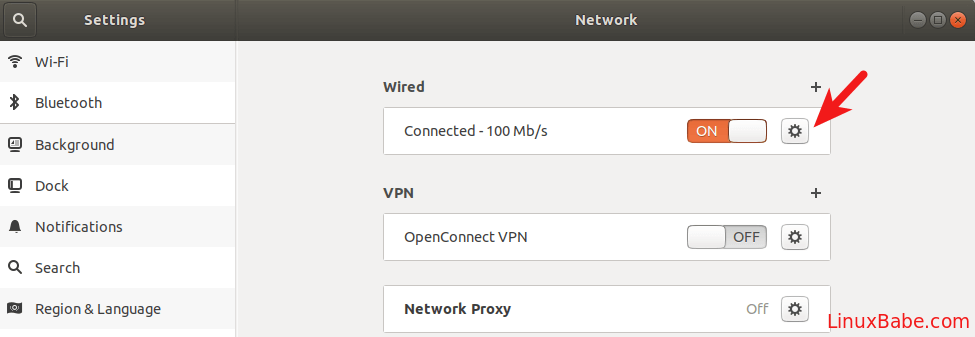
Select IPv4 tab, then in DNS settings, switch Automatic to OFF, which will prevent your Ubuntu system from getting DNS server address from your router. Enter 127.0.0.1 in the DNS field. Click Apply button to save your changes.
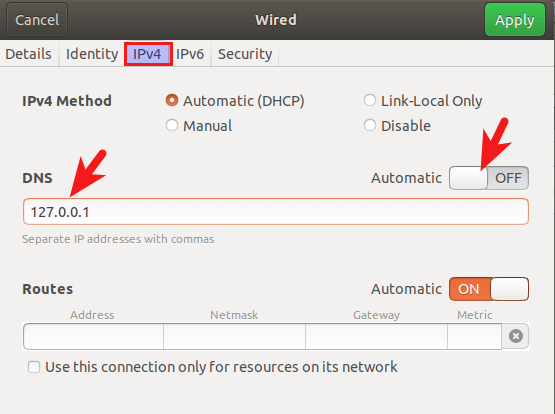
Then restart NetworkManager for the changes to take effect.
sudo systemctl restart NetworkManager
Once you are reconnected, you can see that your Ubuntu system is now using 127.0.0.1 as the DNS server in the Details tab.
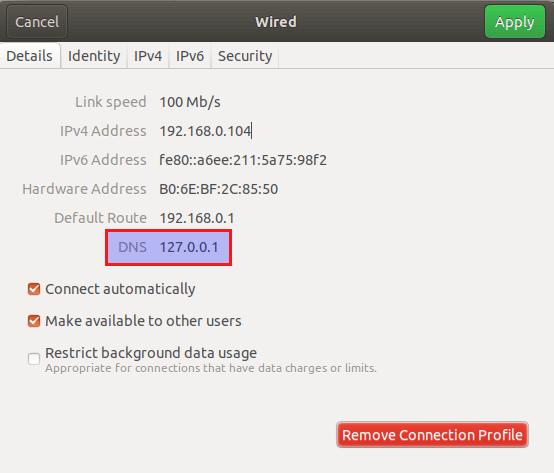
Unity Desktop
Recommended reading: how to install Unity desktop environment on Ubuntu 20.04/18.04.
Click the Network Manager icon on the upper-right corner of your desktop, then click edit connections.
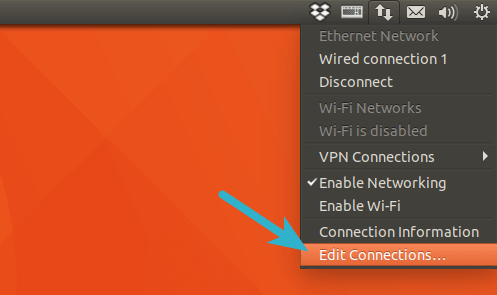
Select your connection name and click the gear icon.
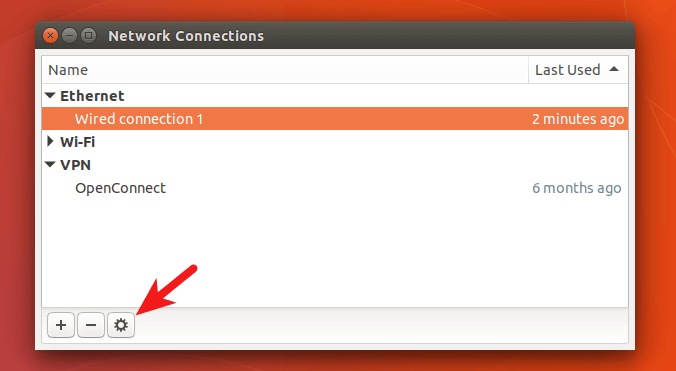
Select IPv4 settings tab, change method from Automatic(DHCP) to Automatic(DHCP) addresses only, which will prevent your Ubuntu system from getting DNS server address from your router. Then specify a DNS server (127.0.0.1). Stubby listens on 127.0.0.1.
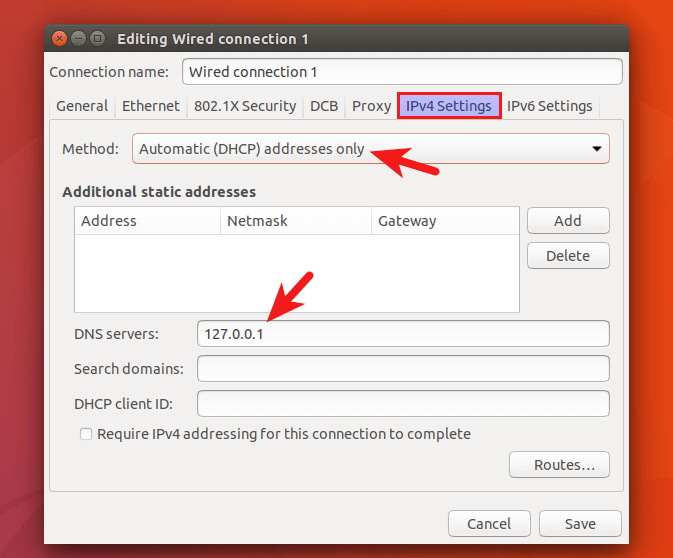
Save your changes. Then restart NetworkManager for the changes to take effect.
sudo systemctl restart NetworkManager
Once you are reconnected, click the Network Manager icon again and select connection information. You can see that your Ubuntu system is now using 127.0.0.1 as the DNS server.
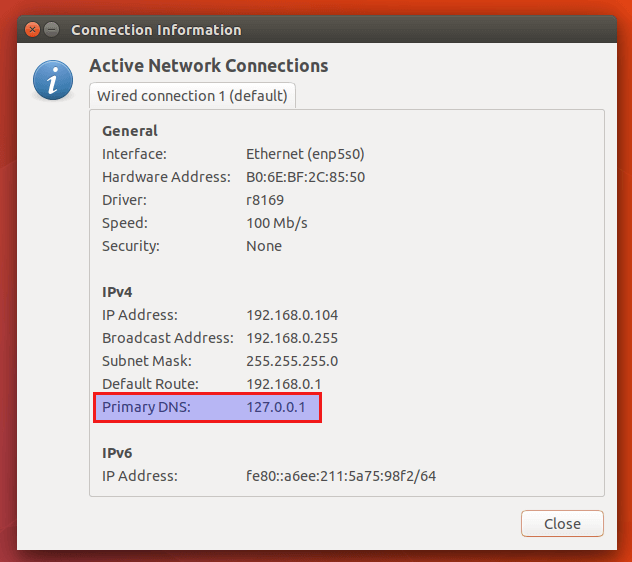
Change DNS Server From Command Line
You can use the method below to change DNS server as long as your desktop environment is using NetworkManager.
Open a terminal window and go to the Network Manager connections profile directory.
cd /etc/NetworkManager/system-connections/
Then list connection names available on your system.
ls

As you can see, I have several connections on my system, one of which is wired connection. Some are wireless connections and one is VPN connection. Because my desktop computer is connected to my router via an Ethernet cable, so I need to edit the wired connection profile with the nano command line text editor.
sudo nano 'Wired connection 1'
If your computer is connected via Wi-fi, then you need to edit the wireless connection profile. In this file, find the [ipv4] configurations. By default, it should look like this:
[ipv4] dns-search= method=auto
To make your system use Stubby, change the configurations to the following.
[ipv4] dns=127.0.0.1; dns-search= ignore-auto-dns=true method=auto
To save the file in Nano text editor, press Ctrl+O, then press Enter to confirm. Press Ctrl+X to exit. Then restart Network Manager for the changes to take effect.
sudo systemctl restart NetworkManager
You can now check your current DNS server by running the following command:
systemd-resolve --status
Sample output:
Link 2 (enp5s0)
Current Scopes: DNS
LLMNR setting: yes
MulticastDNS setting: no
DNSSEC setting: no
DNSSEC supported: no
DNS Servers: 127.0.0.1
If 127.0.0.1 is listed as the DNS server, then your system is using Stubby.
Ignore the DNS Settings Provided by DHCP Server
If you use Ubuntu server edition, you can configure systemd to ignore the DNS settings provided by the DHCP server, so your system won’t be accidentally using the wrong DNS server.
First, check the status of your network interface.
networkctl status enp5s0
It will show you the network file for this interface. Edit this network file.
sudo nano /run/systemd/network/10-netplan-enp5s0.network
Find the [DHCP] section and add the following line.
UseDNS=false
Like this:
[DHCP] RouteMetric=100 UseMTU=true UseDNS=false
Save and close the file. Then restart systemd-netweorkd.service for the change to take effect.
sudo systemctl restart systemd-networkd
Run the following command to check the DNS servers for each network interface. If everything is correct, you won’t see the DNS server provided by your DHCP server.
resolvectl status
Changes in the network file can be overridden by a new package update. If your server uses netplan to manage network connection, you can also configure netplan to ignore DHCP DNS settings.
sudo nano /etc/netplan/50-cloud-init.yaml
Add the following two lines to the file.
dhcp4-overrides:
use-dns: no
Like this:
network:
ethernets:
eth0:
dhcp4: true
dhcp4-overrides:
use-dns: no
optional: true
set-name: eth0
nameservers:
search: [ invalid ]
addresses: 127.0.0.1
version: 2
Save and close the file. Then apply the changes.
sudo netplan apply
How to Check if Your DNS Traffic is Encrypted
We can use WireShark to monitor DNS traffic. Install WireShark from Ubuntu 20.04/18.04 repository.
sudo apt install wireshark
If you are asked “Should non-superusers be able to capture packets?”, answer Yes. Once it’s installed, run the following command to add your user account to the wireshark group so that you can capture packets.
sudo adduser your-username wireshark
Log out and log back in for the changes to take effect. Then open WireShark from your application menu, select your network interface in WireShark. For example, my Ethernet interface name is enp5s0. Then enter port 853 as the capture filter. This will make WireShark only capture traffic on port 853, which is the port used by DNS over TLS.

Click the button on the upper-left corner to start capturing. After that, in terminal window, run the following command to query domain name by using the dig utility. For instance, I can query the A record of my domain name.
dig A linuxbabe.com
Now you can see the captured DNS traffic in WireShark. As you can see, my DNS query was sent to 185.49.141.37, 145.100.185.15 and 145.100.185.16, which are the 3 default DNS resolvers defined in stubby configuration file. Connections were made over TCP and encrypted with TLS, which is what I want.
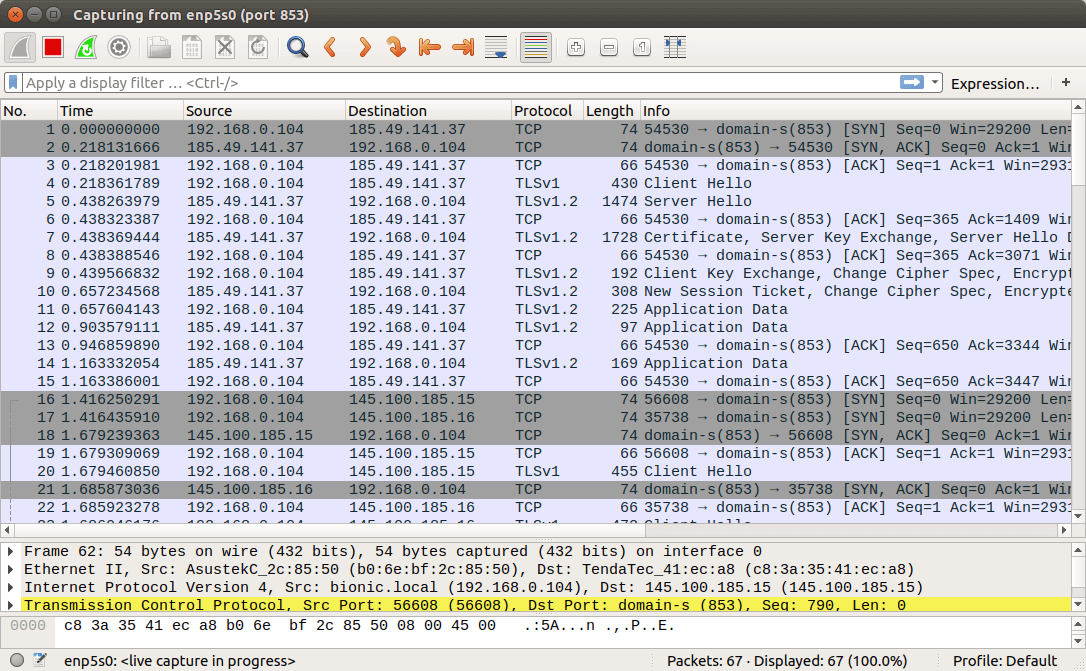
If DNS queries are sent without encryption, then the computer would contact DNS server on port 53. You can capture packets again with port 53 as the capture filter, but you won’t see any packets in WireShark, which means stubby is encrypting your DNS queries.
How to Add CloudFlare DNS to Stubby
I found that there is high latency (over 200ms) between my computer and the 3 default DNS servers, whereas CloudFlare DNS servers (1.1.1.1, 1.0.0.1) give me very low latency (below 20ms). CloudFlare also supports DNS over TLS. To add CloudFlare DNS server, edit stubby configuration file.
sudo nano /etc/stubby/stubby.yml
Scroll down to the upstream_recursive_servers: section and add the following text above other DNS servers.
#CloudFlare servers
- address_data: 1.1.1.1
tls_auth_name: "cloudflare-dns.com"
- address_data: 1.0.0.1
tls_auth_name: "cloudflare-dns.com"
Then find the following line:
round_robin_upstreams: 1
Change 1 to 0. This will make stubby always use CloudFlare DNS server. If CloudFlare is not available, stubby will use other DNS servers. Save the file and restart stubby for the changes to take effect.
sudo systemctl restart stubby
DNS over HTTPS Support
Stubby will support DNS over HTTPS in version 0.3. Ubuntu 20.10 ships with version 0.2.6. To check Stubby version, run
stubby -V
Wrapping Up
I hope this tutorial helped you protect your DNS privacy on Ubuntu 20.04/18.04 with DNS over TLS. As always, if you found this post useful, then subscribe to our free newsletter to get more tips and tricks. Take care.



I am on Xubuntu 16.04… as such, stubby is not in the repository. I am a relatively amateur Linux user, so I was wondering if I could get some alternative instructions for my scenario. TIA. (I’ve included what happens when I go to install stubby).
“sudo apt-get install stubby
Reading package lists… Done
Building dependency tree
Reading state information… Done
E: Unable to locate package stubby”
You can compile stubby from source and create a systemd service unit.
You can also try upgrading from 16.04 to 18.04. Eventually, you will need to do this when 16.04 reaches end of life.
sir, what about opendns, whether it can be used as DNS over TLS. how to use stubby under Ubuntu 16.04 LTS desktop. It is not in the repository.
whether stubby can be installed from the following for Ubuntu 16.04 (https://gist.github.com/LeeiFrankJaw/0735005da8ecbb730861ea03b7af261b). going for fresh install of 18.04 always there. would like to use opendns or ibm quad or googld dns or native dns provider. how to check whether native dns provider supports dns over tls?
Hi
I have got Stubby install and config the file as above mention but when I issue the command “systemd-resolve –status” I got this output as below. Is my traffic DNS over TLS? I am using Linux Mint 19 Tara XFCE
dell@dell-XPS-M1330:~$ systemd-resolve –status
Global
DNSSEC NTA: 10.in-addr.arpa
16.172.in-addr.arpa
168.192.in-addr.arpa
17.172.in-addr.arpa
18.172.in-addr.arpa
19.172.in-addr.arpa
20.172.in-addr.arpa
21.172.in-addr.arpa
22.172.in-addr.arpa
23.172.in-addr.arpa
24.172.in-addr.arpa
25.172.in-addr.arpa
26.172.in-addr.arpa
27.172.in-addr.arpa
28.172.in-addr.arpa
29.172.in-addr.arpa
30.172.in-addr.arpa
31.172.in-addr.arpa
corp
d.f.ip6.arpa
home
internal
lines 1-23
If the output of
systemd-resolve --statuscontainsDNS Servers: 127.0.0.1, then your system is using Stubby.I’m not using XFCE desktop, but I added instructions on changing DNS server from command line. Please see “A Desktop-Agnostic Way to Change DNS Server” section in this article.
Dear Xiao Guo
Thank you.
Thank you Xiao, very useful resource.
Below page claims Stubby doesn’t have a cache and it provided a guide on how to enable it on dnsmasq. But what should be done in Ubuntu?
https://wiki.archlinux.org/index.php/Stubby#Local_DNS_cache_configuration
Stubby may not include any caching abilities, but I’m pretty sure systemd-resolved does.
Wow this so easy than install dnscrypt. I don’t know this software works like dnscrypt or not. But i tried using this software, and i can access reddit again. Thank you.
Thanks, great! Now I am DNSoverTLS secured! (
already can support some of it, but has no certificate verification, to name only one problem).
only works when the process ID has at most 3 digits. Once the PID grows to 4 (or 5) digits, 1 (or 2) letters are cut off from the end. So one should
only.
Chosing one of the quad-{1,8,9} DNS providers may be convenient, but we do not know for sure what they are doing with our data.
You can set up your own DNS over HTTPS resolver.
I edited my yml file to just two providers and 5 addresses. 2 IPv4 for each server and one IPv6 for one server. I kept “round_robin_upstreams: 1”. My DNS is working, but how can I check that all 5 entries are working? Is there a log somewhere I can check? I have done numerous checks and have seen both of the servers in my settings be listed, but never concurrently. I just wanted to ensure all 5 addresses are correct. Thanks.
If Wireshark shows your 5 addresses, then your computer is using the 5 addresses in a round-robin fashion.
兄弟,搞一篇文章 ,谈谈如何搭建‘dns-over-tls’ server吧。我搞了好久,都没搞好
Hey bro, how to set up a dns-over-tls server? I can’t manage to configure it properly.
想写一篇,但暂时有其他事。
I intended to write an article on this, but I don’t have time right now.
Setting up a DNS-over-TLS server is actually very simple.
First, you need to set up a dns resolver using BIND, unbound, or whatever DNS software you prefer. You can check out my BIND tutorial below.
Then you can set up Nginx to act as a DNS proxy for BIND. Add the following lines in
/etc/nginx/nginx.conffile. They need to be placed outside of thehttpcontext.stream { # DNS upstream pool upstream dns { zone dns 64k; server 127.0.0.1:53; } # DoT server for decryption server { listen 853 ssl; ssl_certificate /etc/letsencrypt/live/dot.example.com/fullchain.pem; ssl_certificate_key /etc/letsencrypt/live/dot.example.com/privkey.pem; proxy_pass dns; } }Nginx will terminate TLS on port 853, then it will redirect DNS requests to the local DNS resolver listening on 127.0.0.1:53. You need to obtain your own TLS certificate from Let’s Encrypt.
Save and close the file. Then test Nginx configuration and restart.
Note that if you use CentOS, you need to allow Nginx to listen on port 853 with the following command.
Open port 853 in firewall.
Ubuntu:
CentOS:
Since we are using DNS over TLS, there’s no need to worry about DNS amplification attack.
Now configure Stubby to use your own DNS over TLS server.
Thank you, it was quite easy to do with your instructions…
I’ve just realized that youtube does not work… Do you have any idea why?
🙂 Very sorry, it is kind of sown in my country at the moment…
If I used your previous tutorial when creating a local DNS server on linux, the queries from that DNS server don’t have TLS encryption by default as I understand. So using this tutorial on top of the previous one will work right?
To use your own DNS over TLS resolver, you need to set up one at a remote location like a VPS (virtual private server). To set up a DNS over TLS resolver on a VPS, please read this comment.
Thank you for the detailed explanations!
I assume these instructions work for 20.04 just as well? Maybe even using the same yml file?
Yes.
Hi, I’m running Ubuntu server 20.04.1 with no desktop. How can I change the nameserver?
Thanks for this, was having problems with dnscrypt. This is working great on ubuntu server 20.04. I also use it with dnsmasq for caching and for local dns/dhcp. See the link that Mahdi left.
To set the dns/nameserversd with no GUI or Network nameager in Ubuntu edit the netplan yaml file probably called:
sudo nano /etc/netplan/00-installer-config.yaml
network: ethernets: enp0s8: addresses: - 192.168.1.2/24 gateway4: 192.168.1.1 nameservers: addresses: # This is the setting you are after - 127.0.0.1 version: 2hello I’m using stubby version 0.3.0, however I couldn’t find a way to use DoH instead of DoT do you have any tutorial/documentation about it?
There’s currently no documentation for DoH in Stubby. You can use dnscrypt-proxy to enable DoH. Simply run the following command on your Ubuntu desktop and you are done.
By default, dnscrypt-proxy uses Cloudflare DoH resolver.
I need to restart NetworkManager every boot in order for Stubby to work, any solution? i think the DNS is reset to default on every boot
thank you, LinuxBabe, for an excellent tutorial.
Does anyone know if Stubby will work on non-systemd linux? And what would have to be done? Everything I’ve seen entails systemd.
You can check if Stubby is your distro’s repository. If not, you have to manually compile it from source. Read the Stubby documentation.
Xiao,
Thanks. Yes, it is there. But the base repository is from Debian, and I think systemd is the default there. Whereas MX, which is based on Debian, offers both systemd and initd boot options, but defaults to Initd, and thus far I have stuck to initd.
So I installed DNSCrypt-proxy via the repo, for instance, but have been unable to get it to start.
On initd systems, the command is usually
sudo service stubby start.Linux beginners should use systemd in my opinion. If you don’t know how to use initd, then it’s likely you don’t really know why it’s better than systemd. I have been a Linux user for more than 10 years and I don’t use initd distros anymore.
I did try that for dnscrypt, but it brought an error I don’t recall. Trying just now with stubby brought:
stubby: unrecognized service
I have a strong anti-centralization tendency, and have resisted the move to systemd. But it seems the world has gone there. I might need to capitulate.
Thanks for you input!
After consideration, I’ve taken your advice and switched to the systemd boot option. My machine actually runs a bit better now, which for a Vista-era C2D tower surprises me. I then installed the NextDNS client, rebooted, and now have DoH DNS.
Thanks much for your input.
Hello. I’m on Ubuntu 20.04 and the latest Stubby version is 0.2.6. Repo saying that’s the latest available version, however there is info in article that DNS-over-TLS is supported from ver 0.3 and higher. Do you know why I cannot download updated Stubby?
greate writeup
Dear Xiao Guoan
I need your help to see if I have enable DNS over TLS. On my wired connection, I did not put 127.0.0.1 in the DNS for Ipv4 cos I can’t surf. But when I run the command as you instructed, it say active. Therefore please assist to see as per attachment. Thanks
Hi,
Is this guide still valid or do the sinodun.com servers need to be removed?
“The dnsovertls*.sinodun.com servers are no longer present in the Stubby config file as of release 0.4.1 and were decommissioned on 9th Sept 2022.”
Forgot the link…. https://dnsprivacy.org/test_servers/#stubby-configuration
It worked very well on Ubuntu 24.04, I configured quad9 and did the test on.quad9.net and it worked well.
But I have a problem, after doing these leak tests:
– https://browserleaks.com/dns
– https://dnsleaktest.com/
It’s showing my ISP’s dns, and I don’t know how to fix it.
I appreciate the effort put into this post.
I can’t wait to share this with others.